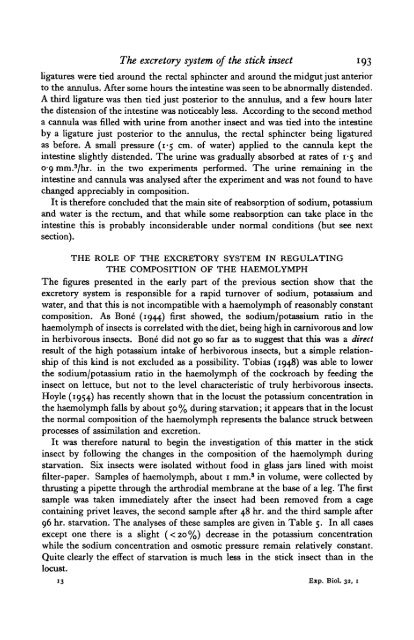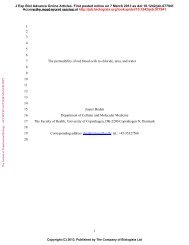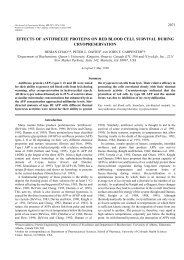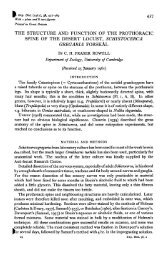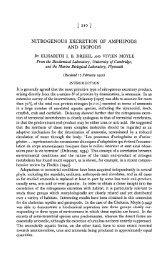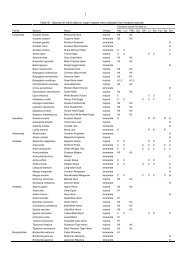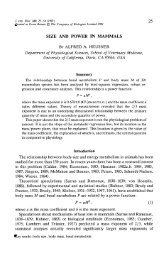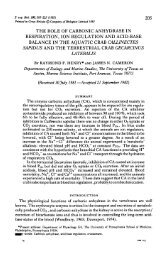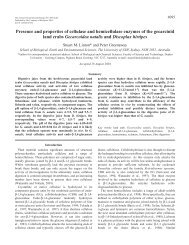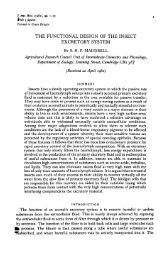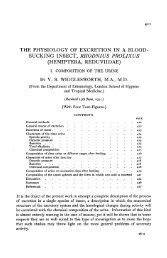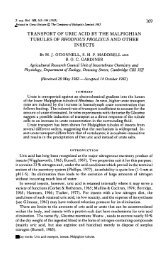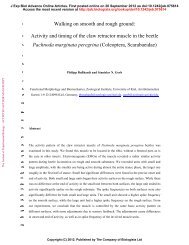the excretory system of the stick insect, dixippus morosus
the excretory system of the stick insect, dixippus morosus
the excretory system of the stick insect, dixippus morosus
Create successful ePaper yourself
Turn your PDF publications into a flip-book with our unique Google optimized e-Paper software.
The <strong>excretory</strong> <strong>system</strong> <strong>of</strong> <strong>the</strong> <strong>stick</strong> <strong>insect</strong> 193<br />
ligatures were tied around <strong>the</strong> rectal sphincter and around <strong>the</strong> midgut just anterior<br />
to <strong>the</strong> annulus. After some hours <strong>the</strong> intestine was seen to be abnormally distended.<br />
A third ligature was <strong>the</strong>n tied just posterior to <strong>the</strong> annulus, and a few hours later<br />
<strong>the</strong> distension <strong>of</strong> <strong>the</strong> intestine was noticeably less. According to <strong>the</strong> second method<br />
a cannula was filled with urine from ano<strong>the</strong>r <strong>insect</strong> and was tied into <strong>the</strong> intestine<br />
by a ligature just posterior to <strong>the</strong> annulus, <strong>the</strong> rectal sphincter being ligatured<br />
as before. A small pressure (1-5 cm. <strong>of</strong> water) applied to <strong>the</strong> cannula kept <strong>the</strong><br />
intestine slightly distended. The urine was gradually absorbed at rates <strong>of</strong> 1-5 and<br />
0-9 mm. 3 /hr. in <strong>the</strong> two experiments performed. The urine remaining in <strong>the</strong><br />
intestine and cannula was analysed after <strong>the</strong> experiment and was not found to have<br />
changed appreciably in composition.<br />
It is <strong>the</strong>refore concluded that <strong>the</strong> main site <strong>of</strong> reabsorption <strong>of</strong> sodium, potassium<br />
and water is <strong>the</strong> rectum, and that while some reabsorption can take place in <strong>the</strong><br />
intestine this is probably inconsiderable under normal conditions (but see next<br />
section).<br />
THE ROLE OF THE EXCRETORY SYSTEM IN REGULATING<br />
THE COMPOSITION OF THE HAEMOLYMPH<br />
The figures presented in <strong>the</strong> early part <strong>of</strong> <strong>the</strong> previous section show that <strong>the</strong><br />
<strong>excretory</strong> <strong>system</strong> is responsible for a rapid turnover <strong>of</strong> sodium, potassium and<br />
water, and that this is not incompatible with a haemolymph <strong>of</strong> reasonably constant<br />
composition. As Bone (1944) first showed, <strong>the</strong> sodium/potassium ratio in <strong>the</strong><br />
haemolymph <strong>of</strong> <strong>insect</strong>s is correlated with <strong>the</strong> diet, being high in carnivorous and low<br />
in herbivorous <strong>insect</strong>s. Bone did not go so far as to suggest that this was a direct<br />
result <strong>of</strong> <strong>the</strong> high potassium intake <strong>of</strong> herbivorous <strong>insect</strong>s, but a simple relationship<br />
<strong>of</strong> this kind is not excluded as a possibility. Tobias (1948) was able to lower<br />
<strong>the</strong> sodium/potassium ratio in <strong>the</strong> haemolymph <strong>of</strong> <strong>the</strong> cockroach by feeding <strong>the</strong><br />
<strong>insect</strong> on lettuce, but not to <strong>the</strong> level characteristic <strong>of</strong> truly herbivorous <strong>insect</strong>s.<br />
Hoyle (1954) has recently shown that in <strong>the</strong> locust <strong>the</strong> potassium concentration in<br />
<strong>the</strong> haemolymph falls by about 50% during starvation; it appears that in <strong>the</strong> locust<br />
<strong>the</strong> normal composition <strong>of</strong> <strong>the</strong> haemolymph represents <strong>the</strong> balance struck between<br />
processes <strong>of</strong> assimilation and excretion.<br />
It was <strong>the</strong>refore natural to begin <strong>the</strong> investigation <strong>of</strong> this matter in <strong>the</strong> <strong>stick</strong><br />
<strong>insect</strong> by following <strong>the</strong> changes in <strong>the</strong> composition <strong>of</strong> <strong>the</strong> haemolymph during<br />
starvation. Six <strong>insect</strong>s were isolated without food in glass jars lined with moist<br />
filter-paper. Samples <strong>of</strong> haemolymph, about 1 mm. 3 in volume, were collected by<br />
thrusting a pipette through <strong>the</strong> arthrodial membrane at <strong>the</strong> base <strong>of</strong> a leg. The first<br />
sample was taken immediately after <strong>the</strong> <strong>insect</strong> had been removed from a cage<br />
containing privet leaves, <strong>the</strong> second sample after 48 hr. and <strong>the</strong> third sample after<br />
96 hr. starvation. The analyses <strong>of</strong> <strong>the</strong>se samples are given in Table 5. In all cases<br />
except one <strong>the</strong>re is a slight (


